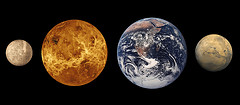
- Image by Royalty-free image collection via Flickr
The search for a second Earth gets serious
IN THE 19th century astronomers spent a lot of time seeking shadows crossing the sun. They were searching for Vulcan, a putative planet inside the orbit of Mercury, by looking for its transits. These are the moments when, viewed from Earth, the hypothetical planet would cross the solar disc. Sadly, there was no Vulcan to be found, but the method itself is sound, and it is the modus operandi of Kepler, an American spacecraft that has been trailing the Earth, in the same orbit, since March 2009.
Kepler is a telescope that looks simultaneously and continuously at more than 150,000 stars, recording the amount of light coming from them. It is seeking the tiny, periodic diminutions of illumination caused by planetary transits and, on January 4th, the team running it announced that five such patterns had shown up in the first six weeks of the probe’s operation.
The past 15 years have shown that planets are commonplace. More than 400 have been located around stars other than the sun, by looking for the wobbles in parent stars that orbiting planets cause. A decent wobble, though, requires a massive planet, so the wobble method does not favour the discovery of Earth-sized objects. Kepler, however, can find such planets. The Earth itself, in transit, reduces the amount of light an observer would see from the sun by about 0.01%. That is well within Kepler’s range.
Related articles by Zemanta
- Kepler Planet-Hunting Mission Finds 5 New Lightweight Worlds (space.com)
- Brief: NASA’s Kepler spots 5 planets in its first 6 weeks of data (arstechnica.com)
- Most earthlike exoplanet started out as a gas giant (scienceblog.com)
- SuperEarths Common for Other Stars (usnews.com)









